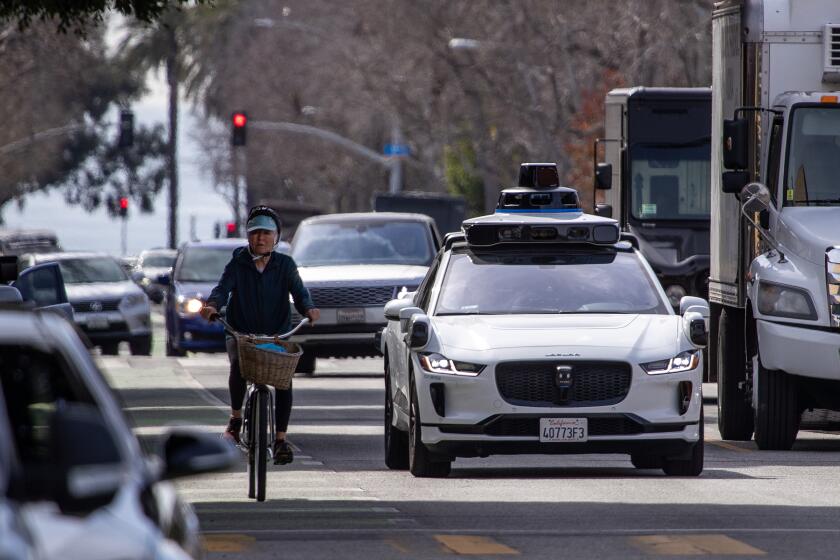Built in 1930s, Bottling Plant Still Shipshape
- Share via
The stretch of Central Avenue that crosses Pico and Olympic boulevards is a hotbed of the city’s thriving low-tech economy.
On side streets, small garment factories operate in boxy single-story buildings with barred windows. Massive wholesale produce and fish markets keep Central Avenue packed with rumbling container trucks.
In the middle of this gritty industrial scene is the ocean liner-inspired Coca-Cola bottling plant, an elegant blend of art and commerce that has graced the avenue since the 1930s. While many landmark buildings downtown languish vacant or with low-rent manufacturing tenants, the Coca-Cola plant still produces soda for Los Angeles consumers, as it has since the days when bottled carbonated soft drinks and shipboard travel were symbols of technical innovation.
The Coca-Cola building is recognized by architects as a grand example of Streamline Moderne, a design style invoking speed and motion with long, flowing lines. The style flourished in 1930s Southern California. As historians David Gebhard and Harriette Von Breton noted in their book, “Los Angeles in the Thirties”: “Streamlining and the Moderne were perfect expressions of an automobile-oriented society. In an affirmation of faith in the future, the aesthetics of speed, freedom and mobility were applied to buildings, ocean liners, aircraft, refrigerators, radios--anything.”
Coca-Cola had been at the Central Avenue location for just over 20 years when the steamship structure was built in 1936 and 1937. The company moved to Los Angeles in 1902, opening a two-man bottling operation at Third and Los Angeles streets, then moving several times before landing on Central Avenue in 1915.
The neighborhood was a busy industrial zone, as well as a residential neighborhood of new arrivals from across the country. Ralph J. Bunche, the late diplomat and Nobel Peace Prize winner, grew up nearby. Long before he became mayor of Los Angeles, Tom Bradley visited the plant as a boy, exchanging empty bottles for toys or money.
The plant grew to a complex of four buildings, including warehouses, production lines and offices. By 1936, Stanley Barbee, president of the Coca-Cola Bottling Co. of Southern California, decided to consolidate the four buildings into one.
Barbee hired architect Robert V. Derrah. A few years earlier, Derrah designed another landmark, the Crossroads of the World shopping center in Hollywood, which features a Streamline Moderne ship-shaped building.
Derrah and Barbee, an avid yachtsman, decided a ship motif would project the attributes Coca-Cola sought to promote: modernity, cleanliness and progress.
Fronting Central Avenue, Derrah’s ocean liner features two rows of porthole windows, a ship’s catwalk with metal railings and simulated rivets fashioned from wood. The Coca-Cola sign atop the building was built in the shape of a ship’s bridge.
The plant’s interior also held to the nautical theme. The mezzanine features mahogany decks and handrails. Ladders and brass fittings add to the look, as do ship doors enclosing the offices. Megaphone-like ventilators dot the upper floors--they were once used as chutes for bottle caps, which were dropped to crowning machines below.
Human-sized terra cotta Coke bottles were later added to the exterior doorways.
The ship-themed parts of the building now house offices, with bottling taking place in larger facilities in another part of the lot.
Lauded by architects since its completion, the building has been the subject of at least two master’s degree theses.
The building was declared a city cultural monument in 1976. Robert Winter, an architectural historian who served on the city’s cultural heritage advisory board at the time, said Coca-Cola officials actually opposed the designation initially, until they were assured it would not preclude them from adding to the facility.
There are no public tours of the building. Tour buses nevertheless stop outside so architecture buffs can snap photos. “It’s too bad the people of Long Beach felt they had to bring the Queen Mary from England; it was already sailing down Central Avenue,” joked Winter.
Larger bottling facilities in Downey and San Diego now handle more production than the Los Angeles plant. Today, the Central Avenue facility produces soft drinks in two-liter and 20-ounce plastic bottles.
After 100 years of bottling in Los Angeles, 87 of them at Central Avenue, company spokesman Robert W. Phillips said the company has no plans to move production. The plant is running short of warehouse space, Phillips said, but that problem could be solved in the future if nearby or adjacent lots become available. “We’re committed to being in this location. We’ve been here so long, we’re committed to it and to remaining in the city,” Phillips said.
More to Read
Inside the business of entertainment
The Wide Shot brings you news, analysis and insights on everything from streaming wars to production — and what it all means for the future.
You may occasionally receive promotional content from the Los Angeles Times.










